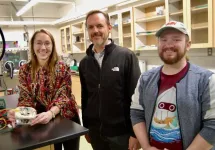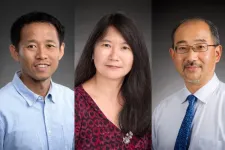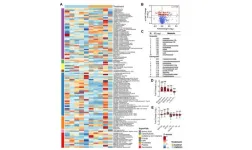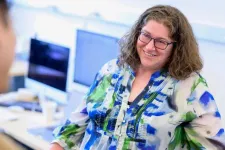(Press-News.org) Algorithms were supposed to make our lives easier and fairer: help us find the best job applicants, help judges impartially assess the risks of bail and bond decisions, and ensure that healthcare is delivered to the patients with the greatest need. By now, though, we know that algorithms can be just as biased as the human decision-makers they inform and replace.
What if that weren’t a bad thing?
New research by Carey Morewedge, a Boston University Questrom School of Business professor of marketing and Everett W. Lord Distinguished Faculty Scholar, found that people recognize more of their biases in algorithms’ decisions than they do in their own—even when those decisions are the same. The research, publishing in the Proceedings of the National Academy of Sciences, suggests ways that awareness might help human decision-makers recognize and correct for their biases.
“A social problem is that algorithms learn and, at scale, roll out biases in the human decisions on which they were trained,” says Morewedge, who also chairs Questrom’s marketing department. For example: In 2015, Amazon tested (and soon scrapped) an algorithm to help its hiring managers filter through job applicants. They found that the program boosted résumés it perceived to come from male applicants, and downgraded those from female applicants, a clear case of gender bias.
But that same year, just 39 percent of Amazon’s workforce were women. If the algorithm had been trained on Amazon’s existing hiring data, it’s no wonder it prioritized male applicants—Amazon already was. If its algorithm had a gender bias, “it’s because Amazon’s managers were biased in their hiring decisions,” Morewedge says.
“Algorithms can codify and amplify human bias, but algorithms also reveal structural biases in our society,” he says. “Many biases cannot be observed at an individual level. It’s hard to prove bias, for instance, in a single hiring decision. But when we add up decisions within and across persons, as we do when building algorithms, it can reveal structural biases in our systems and organizations.”
Morewedge and his collaborators—Begüm Çeliktutan and Romain Cadario, both at Erasmus University in the Netherlands—devised a series of experiments designed to tease out people’s social biases (including racism, sexism, and ageism). The team then compared research participants’ recognition of how those biases colored their own decisions versus decisions made by an algorithm. In the experiments, participants sometimes saw the decisions of real algorithms. But there was a catch: other times, the decisions attributed to algorithms were actually the participants’ choices, in disguise.
Across the board, participants were more likely to see bias in the decisions they thought came from algorithms than in their own decisions. Participants also saw as much bias in the decisions of algorithms as they did in the decisions of other people. (People generally better recognize bias in others than in themselves, a phenomenon called the bias blind spot.) Participants were also more likely to correct for bias in those decisions after the fact, a crucial step for minimizing bias in the future.
Algorithms Remove the Bias Blind Spot
The researchers ran sets of participants, more than 6,000 in total, through nine experiments. In the first, participants rated a set of Airbnb listings, which included a few pieces of information about each listing: its average star rating (on a scale of 1 to 5) and the host’s name. The researchers assigned these fictional listings to hosts with names that were “distinctively African American or white,” based on previous research identifying racial bias, according to the paper. The participants rated how likely they were to rent each listing.
In the second half of the experiment, participants were told about a research finding that explained how the host’s race might bias the ratings. Then, the researchers showed participants a set of ratings and asked them to assess (on a scale of 1 to 7) how likely it was that bias had influenced the ratings.
Participants saw either their own rating reflected back to them, their own rating under the guise of an algorithm’s, their own rating under the guise of someone else’s, or an actual algorithm rating based on their preferences.
The researchers repeated this setup several times, testing for race, gender, age, and attractiveness bias in the profiles of Lyft drivers and Airbnb hosts. Each time, the results were consistent. Participants who thought they saw an algorithm’s ratings or someone else’s ratings (whether or not they actually were) were more likely to perceive bias in the results.
Morewedge attributes this to the different evidence we use to assess bias in others and bias in ourselves. Since we have insight into our own thought process, he says, we’re more likely to trace back through our thinking and decide that it wasn’t biased, perhaps driven by some other factor that went into our decisions. When analyzing the decisions of other people, however, all we have to judge is the outcome.
“Let’s say you’re organizing a panel of speakers for an event,” Morewedge says. “If all those speakers are men, you might say that the outcome wasn’t the result of gender bias because you weren’t even thinking about gender when you invited these speakers. But if you were attending this event and saw a panel of all-male speakers, you’re more likely to conclude that there was gender bias in the selection.”
Indeed, in one of their experiments, the researchers found that participants who were more prone to this bias blind spot were also more likely to see bias in decisions attributed to algorithms or others than in their own decisions. In another experiment, they discovered that people more easily saw their own decisions influenced by factors that were fairly neutral or reasonable, such as an Airbnb host’s star rating, compared to a prejudicial bias, such as race—perhaps because admitting to preferring a five-star rental isn’t as threatening to one’s sense of self or how others might view us, Morewedge suggests.
Algorithms as Mirrors: Seeing and Correcting Human Bias
In the researchers’ final experiment, they gave participants a chance to correct bias in either their ratings or the ratings of an algorithm (real or not). People were more likely to correct the algorithm’s decisions, which reduced the actual bias in its ratings.
This is the crucial step for Morewedge and his colleagues, he says. For anyone motivated to reduce bias, being able to see it is the first step. Their research presents evidence that algorithms can be used as mirrors—a way to identify bias even when people can’t see it in themselves.
“Right now, I think the literature on algorithmic bias is bleak,” Morewedge says. “A lot of it says that we need to develop statistical methods to reduce prejudice in algorithms. But part of the problem is that prejudice comes from people. We should work to make algorithms better, but we should also work to make ourselves less biased.
“What’s exciting about this work is that it shows that algorithms can codify or amplify human bias, but algorithms can also be tools to help people better see their own biases and correct them,” he says. “Algorithms are a double-edged sword. They can be a tool that amplifies our worst tendencies. And algorithms can be a tool that can help better ourselves.”
Republishers are kindly reminded to uphold journalistic integrity by providing proper crediting, including a direct link back to the original source URL here.
END
Can the bias in algorithms help us see our own?
New research by Questrom’s Carey Morewedge shows that people recognize more of their biases in algorithms’ decisions than they do in their own—even when those decisions are the same
2024-04-09
ELSE PRESS RELEASES FROM THIS DATE:
This device gathers, stores electricity in remote settings
2024-04-09
Today wirelessly connected devices are performing an expanding array of applications, such as monitoring the condition of engines and machinery and remote sensing in agricultural settings. Systems known as the “Internet of Things” (IoT), hold much potential for improving the efficiency and safety of the equipment.
Yet stumbling blocks remain for IoT, thwarting many potential applications. How do you power these devices in situations where and when reliable electrical sources are not practically available?
Research from the University of Utah’s College of Engineering points to a possible solution in the form of a novel type of battery called ...
AACR: Video educates and connects men to prostate cancer screening options
2024-04-09
SAN DIEGO – As part of a comprehensive effort to improve cancer screenings among diverse communities, Penn Medicine’s Abramson Cancer Center (ACC) Community Outreach and Engagement team developed a culturally sensitive educational video to address prostate cancer screening disparities. In findings shared today at the American Association for Cancer Research (AACR) Annual Meeting 2024 (Abstract LB371), the team showed that the video increased knowledge about prostate cancer and screening, and reduced uncertainty about obtaining prostate ...
Culturally sensitive video targeting Black men may help increase awareness about prostate cancer
2024-04-09
SAN DIEGO – A video designed to educate Black men about prostate cancer resulted in 97% of surveyed participants acknowledging that Black men are at a higher risk of this disease and 93% saying they would get screened, according to a study presented at the American Association for Cancer Research (AACR) Annual Meeting 2024, held April 5-10.
Black men have the highest incidence of prostate cancer in the United States with 184.2 new cases per 100,000 people compared to white men with 111.5 new cases per 100,000 people, according to the National Cancer Institute’s Surveillance, ...
St. Jude survivorship portal brings researchers ‘one-click’ away from discovery
2024-04-09
(MEMPHIS, Tenn. – April 9, 2024) Scientists from St. Jude Children’s Research Hospital today announced the St. Jude survivorship portal — the first data portal for sharing, analyzing and visualizing pediatric cancer survivorship data. Details on the portal and its ability to facilitate breakthroughs in pediatric cancer survivorship research were published today in Cancer Discovery, a journal of the American Association for Cancer Research.
The survivorship portal is a big-data platform that incorporates clinical and genomic information, creating an unprecedented research system. The portal integrates three dimensions ...
System uses artificial intelligence to detect wild animals on roads and avoid accidents
2024-04-09
Just as in Brazil drivers can be warned of traffic congestion ahead or a vehicle parked on the hard shoulder, notifications may soon pop up on their smartphone or on their car’s computer screen to warn them in real time that an anteater, wolf or tapir is crossing the highway. No human will necessarily need to see the animal in question or press a control button to send the warning.
For this to be possible, a key step is construction of a computer vision model that automatically detects Brazilian wild animals. Researchers ...
Has remote work changed how people travel in the U.S?
2024-04-09
The prevalence of remote work since the start of the Covid-19 pandemic has significantly changed urban transportation patterns in the U.S., according to new study led by MIT researchers.
The research finds significant variation between the effects of remote work on vehicle miles driven and on mass-transit ridership across the U.S.
“A 1 percent decrease in onsite workers leads to a roughly 1 percent reduction in [automobile] vehicle miles driven, but a 2.3 percent reduction in mass transit ridership,” says Yunhan Zheng SM ’21, PhD ’24, an MIT postdoc who is co-author of the study.
“This is one of the first studies that identifies the causal effect ...
UC Irvine scientist helps link climate change to Madagascar’s megadrought
2024-04-09
Irvine, Calif., April 9, 2024 — A University of California, Irvine-led team reveals a clear link between human-driven climate change and the years-long drought currently gripping southern Madagascar. Their study appears in the Nature journal Climate and Atmospheric Science.
“Using remotely sensed observations and climate models, we could see evidence that climate change is affecting the hydrological cycle in southern Madagascar, and it’s likely going to have big implications for the people that live there and how they grow their food,” ...
CMS121 mitigates aging-related obesity and metabolic dysfunction
2024-04-09
“[...] CMS121 applicability could be expanded from a geroneuroprotector drug to a metabolic drug [...]”
BUFFALO, NY- April 9, 2024 – A new research paper was published in Aging (listed by MEDLINE/PubMed as "Aging (Albany NY)" and "Aging-US" by Web of Science) Volume 16, Issue 6, entitled, “CMS121: a novel approach to mitigate aging-related obesity and metabolic dysfunction.”
Modulated by differences in genetic and environmental factors, laboratory mice often show progressive weight gain, eventually leading to obesity and metabolic dyshomeostasis. ...
AACR: How cellular plasticity drives cancer metastasis
2024-04-09
About 90% of deaths from cancer are a result of metastasis — that is, from cancer’s ability to spread from an initial primary tumor to seed new tumors throughout the body, often in the lungs, liver, and brain.
And metastasis relies on cancer cells’ ability to adapt to different tissue environments throughout the body by gaining improper access to a variety of playbooks stored in our genetic code — including gene programs that are generally available only during early stages of human development.
Today, researchers at Memorial Sloan Kettering Cancer Center (MSK) are using innovative approaches like single-cell sequencing technology ...
Free public education event on neuromodulation therapies to be held at Vancouver Convention Centre
2024-04-09
Vancouver, BC – The Canadian Neuromodulation Society and the International Neuromodulation Society (INS) are delighted to announce a public education event, "Understanding Neuromodulation of the Brain and Spinal Cord”.
This complimentary event is scheduled to take place at the Vancouver Convention Centre, East Building, on Saturday, May 11, from 13:30 to 18:00, during the 16th INS World Congress.
Aimed at patients, their families, and friends dealing with conditions such as chronic pain, Parkinson’s disease, and tremor, this event is ...
LAST 30 PRESS RELEASES:
Revealing the diversity of olfactory receptors in hagfish and its implications for early vertebrate evolution
Development of an ultrasonic sensor capable of cuffless, non-invasive blood pressure measurement
Longer treatment with medications for opioid use disorder is associated with greater probability of survival
Strategy over morality can help conservation campaigns reduce ivory demand, research shows
Rising temperatures reshape microbial carbon cycling during animal carcass decomposition in water
Achieving ultra-low-power explosive jumps via locust bio-hybrid muscle actuators
Plant-derived phenolic acids revive the power of tetracycline against drug-resistant bacteria
Cooperation: A costly affair in bacterial social behaviour?
Viruses in wastewater: Silent drivers of pollution removal and antibiotic resistance
Sub-iethal water disinfection may accelerate the spread of antibiotic resistance
Three in four new Australian moms struggle with body image
Post-stroke injection protects the brain in preclinical study
Cardiovascular risk score predicts multiple eye diseases
Health: estimated one in ten British adults used or interested in GLP-1 medications for weight loss
Exercise to treat depression yields similar results to therapy
Whooping cough vaccination for pregnant women strengthens babies’ immune system
Dramatic decline in new cases of orphanhood in Uganda driven by HIV treatment and prevention programs
Stopping weight loss drugs linked to weight regain and reversal of heart health markers
Higher intake of food preservatives linked to increased cancer risk
Mass General Brigham–developed cholera vaccine completes phase 1 trial
First experimental validation of a “150-year-old chemical common sense” direct visualization of the molecular structural changes in the ultrafast anthracene [4+4] photocycloaddition reaction
Lack of support for people on weight loss drugs leaves them vulnerable to nutritional deficiencies, say experts
Dogs’ dinners can have greater climate impact than owners’
Are you ready to swap salmon for sprats and sardines?
1.6 million UK adults used weight loss drugs in past year
American College of Cardiology comments on new dietary guidelines for Americans
American Society of Gene & Cell Therapy and Orphan Therapeutics Accelerator partner to advance and commercialize promising rare disease treatments
One in 14 patients having day case surgery have new or worse chronic pain 3 months after their operation
New study highlights link between eviction rates and gun violence
Heatwaves heat up soil but not toxin levels in rice, study finds
[Press-News.org] Can the bias in algorithms help us see our own?New research by Questrom’s Carey Morewedge shows that people recognize more of their biases in algorithms’ decisions than they do in their own—even when those decisions are the same






